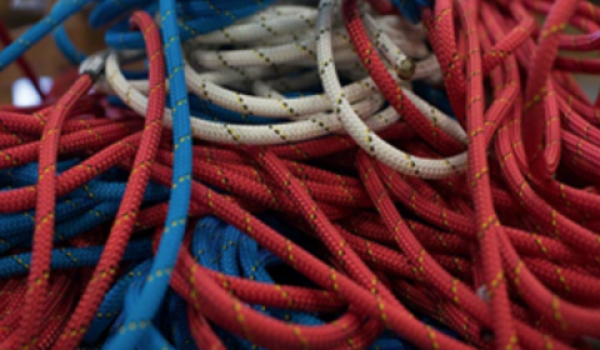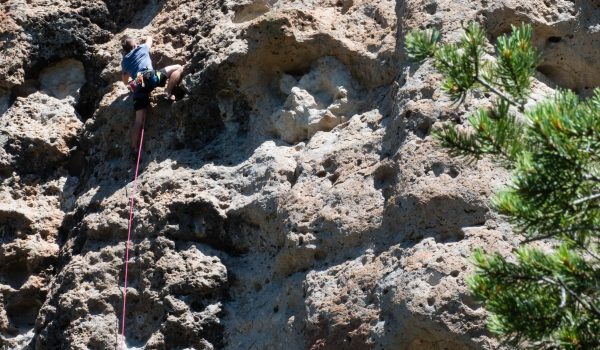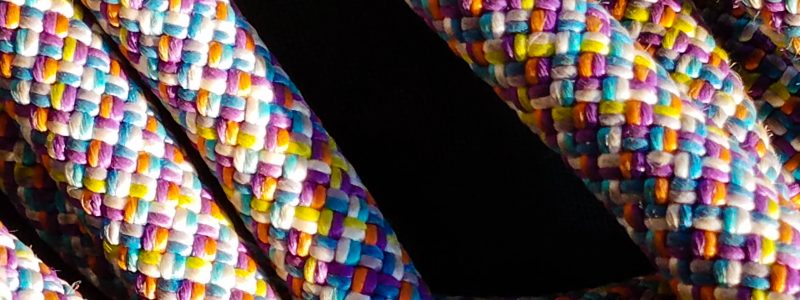
The Best Climbing Ropes
Our team of experts test the best climbing ropes in three main categories: skinny, midsize and thick climbing ropes.
We divided our rope tests into three categories. Skinny ropes are 9.2 mm in diameter and under and are typically the ropes chosen by weight conscious sport climbers for high end redpoint attempts or ice and alpine climbers who are looking to save weight and aren’t concerned about durability. Midsize ropes run the gamut of 9.3 to 9.6 mm and represent a middle ground between weight and durability and are popular with climbers for long traditional routes or sport climbers who want one rope for both projecting and redpoints. Thick ropes range from 9.7 to 10.5 mm and are the rope of choice for climbers who want the durability afforded by a thicker rope, particularly climbers who will be toproping a lot or climbers who want the extra security offered by a thicker rope.
How to Select the Best Climbing Rope for You
The Best Climbing Ropes by: Mike Schneiter
Your climbing rope is one of the most important purchases you’ll make. It’s likely the single most expensive piece of equipment you’ll purchase for climbing and it provides security every time use it, whether for lowering or on a big fall. On top of all that, you can develop an intimate relationship with your rope as you handle it repeatedly for clips and tying in or when coiling it at the end of the day, causing many climbers to love their rope or to view it with scorn if it doesn’t perform like they want. We’ve created a series of steps to guide you through the rope buying process and help you buy the best rope for your needs.
Choose Your Diameter
What type of climber are you? Where are you going to use the rope primarily? Sport? Trad? Single pitch cragging or long multipitch routes? Rock or ice or both? Alpine climbing or mountaineering? In choosing a rope the first thing you’ll want to consider is the rope diameter. Determining the type of climbing you are most likely to use the rope may be the biggest factor in choosing the rope diameter. You may also consider if the rope is going to serve a specialized function or if you’re looking for a one-size-fits-all rope that gets used for all of your climbing.
Thick Ropes
Thick ropes are the workhorse ropes that are made to take a beating. Twenty years ago the workhorse rope may have been a fat 11 mm model but today you’ll find fewer of those thick cords on the market. Many manufacturers climbing rope line tops out somewhere in the area 10 mm and ropes beyond that often are relegated to institutional use by schools, guides and groups whose sole mission is toproping. Hence, we’ve focused on 9.7 to 10.2 mm as today’s thick rope size.
For many today, a rope in this range is their first rope purchase, as evidenced by the 9.8 size being one of the two most popularly sold rope sizes at online retailer Backcountry.com. Thick ropes are going to be heavier than their skinnier counterparts but they are also more durable and can withstand greater abuse from sharp rock and repeated falls, typically due to a thicker sheath. Ropes in this size range can be a popular size for climbers who want a durable toprope or for a sport climber who isn’t pushing the limits with hard redpoints and onsights. Some trad or multi-pitch climbers may favor a rope in this range if they are climbing on sharp rock or where abrasion resistance is key. If you’re climbing big wall routes, like El Capitan, a rope in this size range may be what you’re looking for.
Midsize Ropes
Midsize ropes represent a balance between the low weight of a smaller diameter rope and the durability found in a thicker rope. That balance has caused midsize ropes in the area of 9.5 mm to be popular choice. We’ve identified midsize ropes to be in the 9.3 to 9.6 mm size range and for many climbers a midsize rope may be the only rope they own if they are looking for a single rope to own.
Midsize ropes often have favorable handling according to testers, likely to less sheath material and the smaller diameter. The easy, smooth clipping and knot tying in the midsize ropes make them popular for sport climbers who want a more performance oriented rope, shedding weight while sacrificing durability compared to a thicker rope. Climbers who like to get off the deck on long routes may appreciate a midsize rope for its weight savings and easy handling when repeatedly connecting to anchors and coiling rope at belays.
Skinny Ropes
Throughout the outdoor industry weight savings have long been a popular trend and no longer are climbers left to coil up and carry thick heavy ropes for their climbing missions. Today’s offering of skinny ropes have become increasingly popular and found throughout manufacturers. We’ve identified skinny ropes as being those that are 9.2 mm and under with some ropes certified for single rope use getting down into the 8.5 mm range. Skinny ropes represent a big weight savings over their thicker cousins. Consider that a 10.5 mm rope will weigh somewhere around 70 grams/meter and a 9 mm rope 52 grams/meter, that weight savings adds up to over 2-½ pounds for a 70 meter rope. Hence, skinny ropes have long been popular with alpinists and mountaineers who want to shed the weight and aren’t expecting to be taking big falls that would necessitate a thicker rope. Ice climbers also have long gotten into the skinny rope tradition as their medium, frozen water, tends to not require a lot of abrasion resistance.
Increasingly you’ll also see sport climbers utilizing skinny ropes at the crag for hard redpoints and onsights although they may be tying into a thicker cord for their working sessions. Some traditional climbers and particularly those climbing multipitch may seek out a weight saving skinny rope if the rock medium they are climbing on is less abrasive but caution should be used according to your rock and the danger that on some plaquette or guide-style belay devices won’t auto-block effectively with skinny ropes.
Single, Twin and Half Ropes
The category of skinny ropes can also be broken down into single, twin and half ropes, according to UIAA testing and certification. For a rope to be sold as a single climbing rope it must pass UIAA testing that requires a rope to withstand at least 5 falls with an 80 kg mass. All of the ropes we’ve tested are single ropes but many have also been certified as twin and/or half ropes. Half ropes can be clipped to every other piece but twin ropes must be clipped together to each piece and some ropes have multiple certification as both single and half or triple certified as all three; single, twin and half.
Half ropes have some utility with rock climbers who are climbing wandering pitches and want to cut down on rope drag. Twin ropes historically have had some popularity with ice climbers as a way of adding extra security in the case of a misplaced ice pick in one rope but that concern has largely been erased. Instead, both half and twin ropes have the appeal of offering the ability to tie the two ropes together to make long rappels on the descent. Thus, carrying two skinny and lightweight ropes gives a climber the ability to make full rope length rappels. While this system has its merits, many climbers today are more apt to climb on a midsize rope for hard free climbing and then bring along a skinny tag line for use on rappel.
Do you need a dry treated rope?
In buying a rope you’ll notice many ropes come with a dry treatment option. Dry treatments are most popular with ice climbers, alpinists and mountaineers because their rope is coming into contact with water in the form of snow or ice. A dry treated rope can help prevent water being absorbed into the rope which either creates a wet, heavy rope that becomes a bear or worse, a rope that freezes up and turns into a stiff cable. You can think of the dry treatment of a rope like a durable water repellant finish on a jacket, it is designed to keep moisture out of the material.
There’s some appeal for rock climbers as well because dry treated ropes should help keep a rope clean and resistant to dirt. But, be warned as dry treatments are not all created the same and until recently there was no test for the effectiveness of dry treatments. Some companies offer a variety of dry treatments to reflect the different approaches and those different treatments affect the price. Some ropes may only have a dry treated sheath while others will feature treatments of both the sheath and the core. The latter are those that are designed to be more truly “dry” and functional.
Any rope can have some measure of dry treatment applies to it and be sold as such. A number of rope washes offer the ability to add some treatment to your rope at home.
In 2014 the UIAA developed a test to qualify ropes as “UIAA Water Repellent” and a few ropes can be found on the market that pass this test. The test involves first putting some abrasion wear on the rope that is meant to simulate a few days of rock climbing. The rope is then submerged for 15 minutes according to a set procedure and when removed can absorb no more than 5 percent of the rope’s weight in water to pass the test. Ropes that feature only a dry treated sheath absorb 20 to 40 percent of their weight in water and untreated ropes will absorb around 50 percent of their weight. Thus, the test is demanding and requires ropes to have fully dry treated sheaths and cores and to a high standard. Some also feel that dry treatment makes for a smoother feeling rope that can reduce rope drag on gear and handle more easily but that’s harder to determine as a rope’s construction is likely a bigger factor in determining its handling characteristics.
Do you need a durable rope or a better handling rope?
Depending on the type of climbing you are will do most often, consider whether you want a more durable rope or a rope that handles better. Durability often comes at the expense of handling, but it’s not a hard and fast rule, and many ropes represent a middle ground between the two. Some ropes are built in such a way to make them a tough, long-lasting workhorse that can withstand repeated abuse, sharp rock and regular whippers.
Some of those durable workhorses have stiff handling that makes them a little tougher to tie secure knots in or inserting into belay devices. They can also be prone to kinking, providing much frustration on multi-pitch routes when the rope stays tied between two people on pitch after pitch and you may find yourself needing to tether in direct to untie and remove the annoying kinks.
While hand is the technically appropriate term for the feel and handle of a rope, we’ve opted for the more commonly used term handling. In terms of handling many ropes have a softer, more supple feel that makes knot tying easier but those same ropes may be more quickly damaged on big falls or when used on abrasive rock.
As a climber, consider what your typical rock medium is and what your intended use is. If your main focus is toproping and your local rock is sharp or abrasive, or if you’re looking for a project rope that can withstand repeated whippers, then a more durable rope may be in your favor. If you’re looking for a rope for long routes where you’re repeatedly pulling up rope, belaying and then coiling the rope a better handling rope may be the ticket. For many climbers they end up with a quiver and they may tote along a durable workhorse for their sport climbing project along with a better handling rope for those hard redpoint or onsight attempts.
Should you get a bicolor pattern rope or a rope with a middle mark?
Finding the middle of the rope is a classic conundrum when on top of a rappel and readying yourself for descent and can made all the more urgent with an approaching storm. On long single pitch climbs that are pushing 30 or 35 meters a middle mark can help a belayer know if they will be able to lower the climber to the ground or if some sort of shenanigans will be needed.
Most ropes on the market today include some method of marking the middle. The most common method is a black mark at the middle. These middle marks can stand out to a varying degree depending largely on the color of rope that it contrasts with but sometimes also due to how dark of a black middle mark a company uses. Over time, some of those middle marks can wear off more quickly than others or become harder to see than others for various reasons, something we kept our eye on when testing ropes.
Middle marks can also be placed on a rope by users with the use of specific pens sold by a few different manufacturers. Years ago the UIAA Safety Commission warned about the safety of these middle marks, finding a decrease in strength of up to 50 percent. They warned against pens sold as rope markers and offered particularly caution for markers, such as Sharpies, that weren’t intended for climbing ropes. Testing from Black Diamond later called those results or concerns into question and some have speculated that middle marks would be particularly dangerous if that section of rope was loaded over a carabiner, meaning you’d be taking a huge fall anyway.
If all this talk of dangerous pens and markers gives you pause you can consider Metolius’ unique Monster Mark which has bright orange colored thread sticking out from the middle mark. Or, you can put out some extra money to buy a bicolor pattern. These ropes have a change in pattern at the midway mark and have the distinct advantage of not wearing out like a black middle mark. Some ropes’ patterns and color schemes are more effective than others for finding the middle and our testers often remarked about bicolor patterns that stood out more than others.
One disadvantage of a bicolor pattern rope is that if you do have to cut the end of a rope due to damage or wear then that middle mark become frustratingly useless and potentially dangerous, only remedied by cutting an equal amount off the other end which can leave a rope too short to be of practical use.
What length of rope should you get?
Years ago 50 meter ropes were pretty standard and today you may find yourself climbing a multi-pitch route established in the 70s or 80s and notice that the belay or rappel anchors are established with that rope length in mind. In recent years 60 meters has become the standard although the 70 meter rope may be challenging for that role. For most climbers focusing on single pitch climbing a 60 meter rope will suffice but an increasing number of climbs are going beyond 30 meters. A lot of it depends on where you climb so check out the route lengths at your favorite crags and when in doubt, throw down the extra money for a 70 meter rope.
Many climbers like knowing that if they do have to cut a damaged end off their 70 meter rope they will have enough rope left to keep it functional for normal cragging. An increasing number of companies are offering 80 meter ropes, which can be very unique to where you climb but many climbers find them useful for some of the long pitches you can find at places like Indian Creek. A few companies also offer rope lengths in sections of 30 or 40 meters which can be great for alpine climbing or mountaineering or for a lead rope you take to the gym.
Look at the Specs
Finally, take a look at the specs on a rope and understand how they may impact the type of climbing you’re looking to do. All ropes sold in a store will include a tag with the “rope specs” and online a retailer will typically include such information. If not, do some research on the rope manufacturer’s website and check out the following specs:
Number of Falls Held or UIAA Falls
Single ropes must be able to hold five falls in UIAA testing and you may assume that a rope that holds more than five falls is stronger, and hence, better. Some falsely assume this is the maximum number of falls that a rope can withstand in real life but realize it’s a laboratory test and not a real world test, involving dropping that 80 kg mass repeatedly from a height of 2.3 meters above an anchor point, generating a 1.77 fall factor. You better not be taking falls like this and doing so repeatedly otherwise you need to get some proper instruction. The number of falls a rope held can be instructive as to the construction used in a rope but check out the following specs to gain more insight and balance out your decision.
Impact Force
A dynamic climbing rope is like a Slinky, the coiled play things for many youth. When you fall, the rope stretches to absorb the force of the fall and after you return to the rock or clip in direct to gear, the rope is able to return to its original form or as some climbers say “give their rope a rest.” If you’ve ever played with various Slinky, including the original metallic version and cheaper plastic versions, you’ll notice some stretch more easily than others. The same is true of ropes and every rope sold will stretch a varying amount, thus absorbing force. This is why we don’t rock climb on static ropes, they would be absolutely brutal on the body when taking whippers because they wouldn’t absorb the force of the fall as well as a dynamic climbing rope.
For every rope sold, the UIAA standard says that a rope must have an impact force rating of 12 kN or less. Over 12 kN and that’s when internal organs starting going splat, at least according to some gruesome Cold War-era space program testing. In general, the lower the impact force for a rope, the more stretch it has to absorb force.
Elongation
Rope specs will include both static and dynamic elongation and give climbers insight into how much a rope is going to stretch when fallen on. For ropes to be solid the UIAA requires a dynamic elongation equal to or less than 40 percent. Consider that if you’re 200 feet up on a mega-long pitch and you fall on a rope with 40 percent dynamic elongation you could fall 80 feet. That’s a big whipper even with a piece of gear at your waist! Hence, consider how much dynamic elongation a rope has and more so if you’re a heavier climber. Heavier climbers exert more impact force but they also cause the rope to stretch a lot more.
Take note when out climbing with little kids, the rope goes almost nowhere when they take a toprope fall but put a 250 pound adult on the same terrain and the rope can stretch significantly, causing plenty of bruised heels and sprained ankles from falls close to the ground on toprope when the rope stretches. In general, a rope with a lower impact force also has higher dynamic elongation but that’s not a universal truth. Ideally, you can find a rope that has a balance between low impact force and low dynamic elongation.

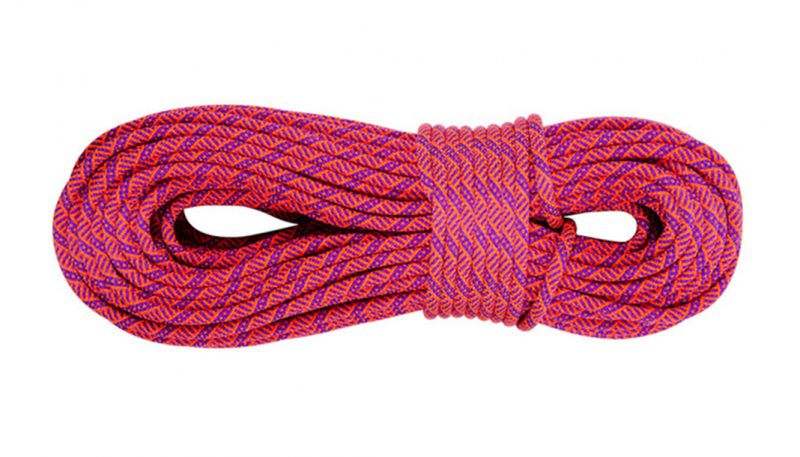
The Sterling Evolution Helix is an effective rope for trad and sport climbing with great handling characteristics for knot tying and belaying. Good durability and resistance to dirt make the Helix a long lasting rope for climbers. The Helix is available with a number of options, such as dry treatment and bi-pattern.
Best For Single Rope Versatility
Maxim Pinnacle Yellow Jacket 9.5
Climbing, Climbing Ropes & Midsize Climbing Ropes
The Maxim Pinnacle Yellow Jacket is a versatile, durable dynamic single climbing rope with a bi-pattern, high-contrast color scheme that makes finding the middle of the rope easy. Maxim’s Endura dry treatment of the sheath and core work great for ice and alpine climbing and the tightly woven sheath is a little stiff but feeds smoothly for sport and trad climbing, making the Pinnacle a great all around rope.
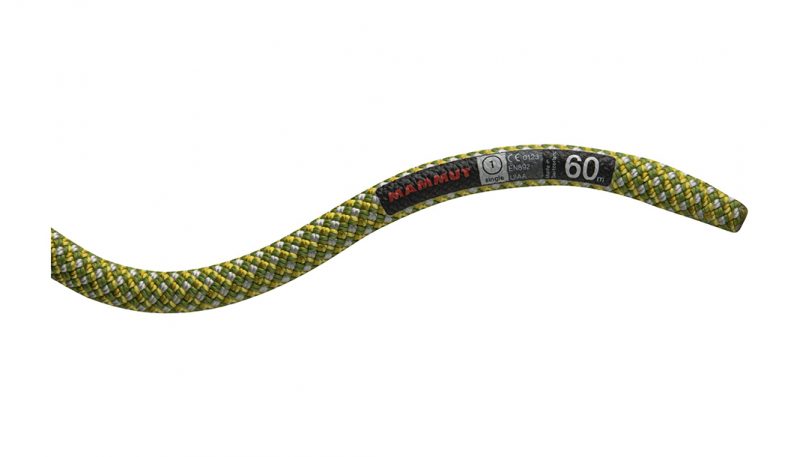
The Mammut Infinity is a great all around rope for rock and ice climbing owing to its good handling and effective dry treatment that passes the UIAA dry treatment standard. The durability of the Infinity makes it popular for both trad and sport climbers seeking a long lasting rope although multipitch climbers may be discouraged by the hard to find middle mark.
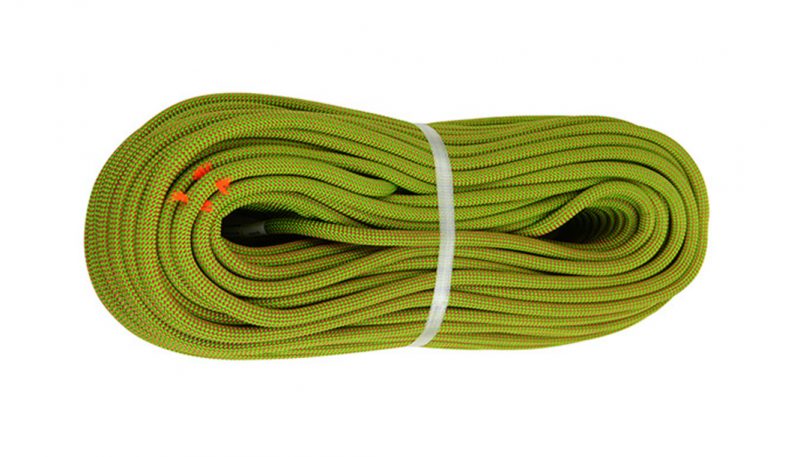
The Metolius Monster is a durable, versatile and well handling dynamic 8.9 mm climbing rope that is certified as a single, twin or half rope. The Monster comes with Complete Shield dry treatment of the sheath and core that was effective at repelling moisture during days of ice and alpine climbing. The Monster Mark, a bright orange thread to aid in finding the halfway point, was popular with testers while being effective and durable.

The Trango Catalyst is a skinny rope (9.0 mm) with the durability and abrasion resistance found in a thicker workhorse rope. This rope handled excellently and the extra security from the Unicore technology impressed testers.
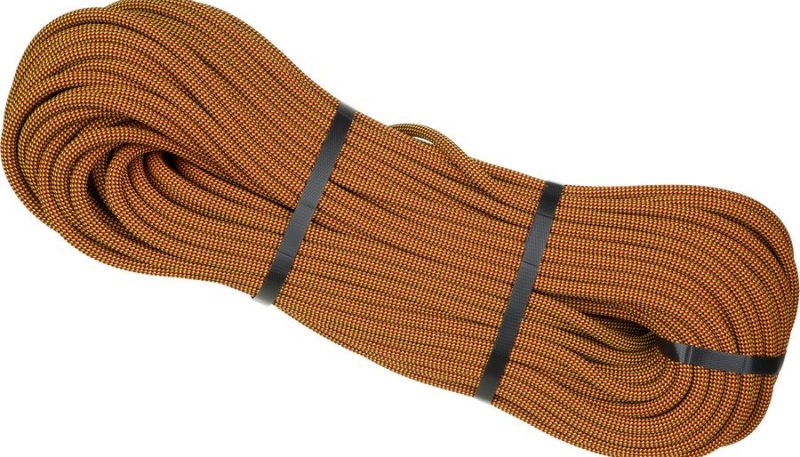
The Maxim Airliner is a 9.1 mm dynamic climbing rope that is dual certified for use as a single and half rope. With an effective Endura Dry double dry treatment, the Airliner was resistant to dirt and provided great durability for a skinny rope, making it a fine option for ice and trad climbing. Stiff handling and kinking during use were the biggest drawbacks of the Airliner, making it less appealing for sport and multi-pitch use.
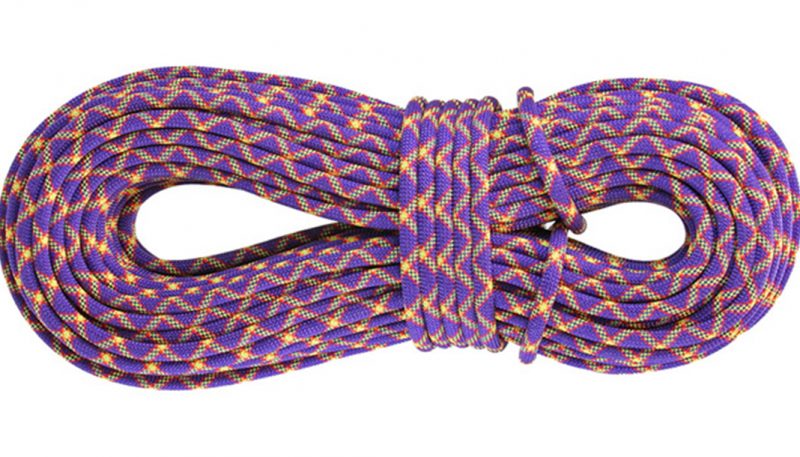
The Sterling Evolution Velocity is a great handling 9.8 mm dynamic climbing rope that excels at sport and traditional rock climbing. Lacking some of the fancy features on other ropes, the Evolution Velocity makes up for it in performance, resistance to dirt, and its wide range of dry treated and length options.
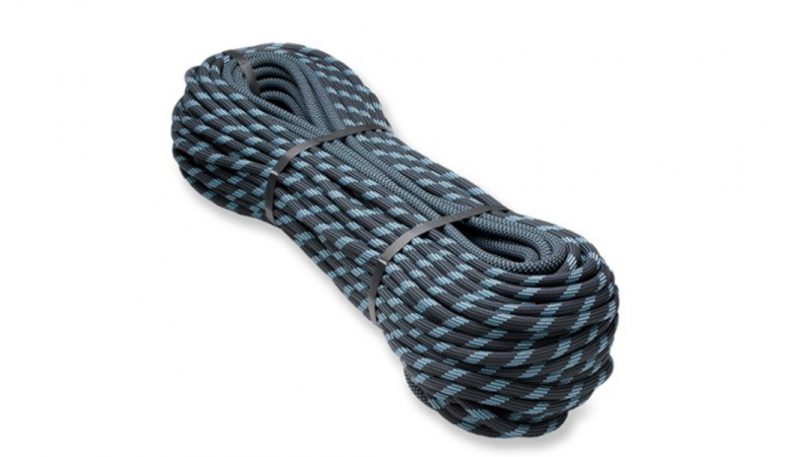
The Maxim Glider is a 9.9 mm rope best suited for sport and trad climbers looking for a durable rope that can hold up to repeated abuse. Stiff handling makes the rope difficult for tying knots and harder to feed through a belay device, limiting its appeal.
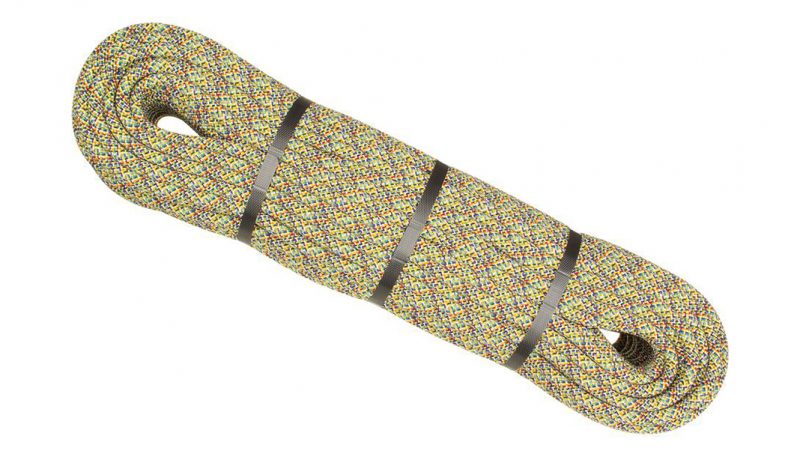
The Edelrid Boa Eco is an environmentally conscious 9.8 mm single climbing rope that uses recycled yarns that offers a unique color pattern in each rope. Good handling characteristics and a middle mark make this rope popular for sport and trad climbers for single pitch climbs. The recycled yarns used are not from recycled used ropes but are new yarns leftover from the rope making process and are completely safe.








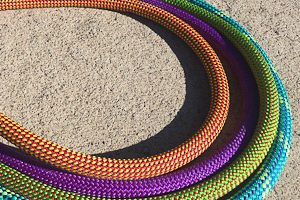
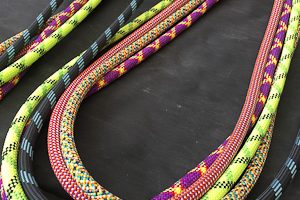
 87
87 